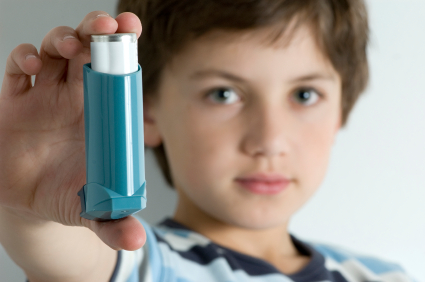Asthma is a common condition that affects many of the population. This article written by a Consultant Physician in Respiratory Medicine describes the risk factors to look out for.
Contents
- Airway inflammation in asthma
- Benefits of identifying asthma triggers
- Difficulties in identifying asthma triggers
- Type of asthma triggers: Indoor environmental inhaled triggers
- Non-inhaled trigger factors
- Summary
Airway inflammation in asthma
Asthma is characterised by the inflammation of airways. The inflamed airways look swollen and red on direct inspection with a fibreoptic bronchoscope and on microscopic examination are infiltrated with inflammatory cells, have damaged epithelial lining, excessive mucus production and leaky blood vessels. These inflammatory changes cause narrowing of airways and exaggerated response (bronchial hyper- reactivity) to various inhaled irritants, infections and allergens (triggers) leading to further narrowing of airways. Depending on the underlying state of the airways and exposure to type of trigger factors, patients with asthma may either develop an acute asthma or asymptomatic reduction in peak expiratory flow rate (PEFR).
Benefits of identifying asthma triggers

In many patients airway inflammation can be controlled effectively with inhaled anti- inflammatory drugs such as inhaled beclomethasone, budesonide or fluticasone. The treatment not only improves airways narrowing but also reduces bronchial hyper-reactivity. However, in some patients asthma remains poorly controlled despite maximum inhaled treatment. In these patients identification and control of trigger factors for asthma may help in achieving asthma control. Furthermore, for patients whose asthma is well controlled with treatment, avoidance of trigger factors may help in maintaining asthma control with less or no treatment.
Finally, reduction in exposure to triggers may help in preventing long term damage to the airways. A primary care practice in South London found that structured allergy evaluation and allergen avoidance in patients with asthma improved lung function and asthma control.
Difficulties in identifying asthma triggers
Identification of triggers such as cigarette smoke on walking into a smoked filled pub or restaurant, leading to cough and wheeze, is easy. However, in most patients with asthma identification of trigger factors requires a systematic approach. Most trigger factors are inhaled irritants, infections and allergen. Since we breathe approximately 10000 litres of air every day, the quality of inhaled air determines the type and amount of inhaled trigger agents reaching the airways. We spend 90% of our time indoors either at home, work or during leisure activity. A detailed enquiry into indoor conditions is much more likely to provide information on factors triggering asthma than outdoor conditions. However, non-inhaled triggers such as gastro-oesophageal reflux (GOR) may not be easy to identify unless specifically enquired about. Sometimes it is difficult to recognise the trigger factors because there are multiple trigger factors, they are not visible or did not affect asthma patients previously (sensitisation) or because of delays between exposure and asthma symptoms (late allergen reaction).
Type of asthma triggers: Indoor environmental inhaled triggers
Home
(i) Allergens: house dust mites are the most common and important indoor allergen. They are present in warm, humid conditions provided by modern centrally heated houses. They are especially present in mattresses and soft furnishings in the bedrooms. Asthma triggered by house dust mite may be obvious to some asthmatics who wheeze during activities
such as cleaning and dusting. However, regular exposure to non-visible house dust mite allergen leading to persistently poorly controlled asthma may not be easy to identify. Skin allergy tests can confirm house dust mite as a possible trigger factor for asthma and simple measures such as use of mite impermeable mattress and pillow covers can help in reducing allergen exposure and improvement of asthma.
Pets, almost all furry mammals such as cats, dogs, horses, hamsters, gerbils, guinea pigs, rats and mice can trigger asthma. Exposure to allergen from these pets is intermittent and relatively obvious. However, cat allergen can be detected in the house and on clothing for several months after removal of a cat from the house.
Mould can exist in damp houses, particularly in bathrooms and kitchens, throughout the year and may not be easy to recognise as a trigger factor for asthma. A history of the onset of asthma symptoms or the worsening of asthma on moving to a new house should lead to enquiry into indoor housing conditions.
(ii) Indoor environmental: pollutants /irritants: generated by cigarette smoking, cooking, painting and decorating are some of the common trigger factors. Second hand smoke is a mixture of smoke from the burning end of a cigarette and smoke exhaled by the smoker. Children of mothers who smoke are at increased risk of developing asthma. Nitrogen oxide is an odourless gas produced as the result of indoor fuel burning such as from gas stoves and fireplaces. Inhalation of high concentrations of nitrogen oxide can increase bronchial hyper-responsiveness, however inhalation of relatively low concentrations of nitrogen oxide commonly encountered indoors can trigger asthma when inhaled with indoor allergens. Inhalation of non-specific irritants from body and hair sprays and perfumes can trigger immediate asthma symptoms. Similarly exposure to irritants generated during the common DIY activity of painting and decorating can worsen asthma.
Work-General Office
(i) Respiratory tract infections: due to rhinovirus, influenza, and respiratory synctial virus spread by droplet infection and direct contact with infected secretions. Therefore, viral respiratory infections are more likely to occur in crowded, indoor house or work conditions, particularly during winter. Respiratory tract viral infection in asthmatic patients is one of most important trigger factors for asthma in winter. Viral infection provokes asthma either by directly damaging the epithelial lining of the bronchi or by synergistic interaction with indoor allergen or air pollutants.
(ii) Pollutants: Indoor pollutants at work such as environmental tobacco smoke should be less of a problem with the introduction of a ban on smoking in public places. However, indoor pollutants generated by office activities such as photocopier machines, warming of plastic materials, newly laid carpets and insulation material are an increasingly common source of indoor door pollutants at work.
Work-Occupational
In addition to dusty, cold or polluted indoor conditions at work which can trigger asthma, certain occupations such as painting and decorating, hairdressing, carpentry, baking, farming and hospital laboratory work expose workers to specific occupational agents that can induce asthma. An enquiry into the relation of asthma symptoms to work, such as improvement in asthma control over the weekend or when on holidays should point to a possible occupational cause for asthma.
Leisure activity
Exposure to respiratory viruses, environmental tobacco smoke and non- specific irritants can also occur in indoor public places during leisure activities such as visiting pubs and restaurants and during travel. However, accidental exposure to high levels of chlorine from indoor swimming pools can trigger asthma.
Outdoor inhaled triggers
Pollen allergy: is obvious in asthma patients with a history of conjunctivitis and rhinitis (hay fever) during the pollen season. It is easy to confirm this with a skin allergy test. Exposure to high level of pollens in asthmatic patients with a history of hay fever can trigger asthma. The asthma symptoms are typically worse during early spring in patients allergic to tree pollens and during summer in asthma patients allergic to grass pollen. High levels of pollen are usually encountered in the evenings.

Outdoor pollutants: are essentially generated from the burning of fossil fuel during driving or accidents such as the fire at the fuel depot in Hemel Hempstead. The main pollutants created are nitrogen oxides, ozone, sulphur dioxide and particulate matter. Exposure to high levels of sulphur dioxide and nitrogen oxides cause bronchoconstriction, however, such high levels are rarely encountered in cities. Particulate matter and ozone can exacerbate asthma. High levels of ozone in the air are associated with 10-20% increase in hospital admissions due to asthma. High levels of ozone are seen on hot summer days and avoidance of outdoor exercise particularly during afternoons may be helpful to avoid the effect of high levels of ozone in the air. Face masks are generally unhelpful in reducing exposure to outdoor pollutants and particulate matter.
Weather: Cold air can provoke asthma in some while others react to hot and humid conditions. Thunderstorms have been known to worsen asthma control and increase hospital admissions.
Non-inhaled trigger factors
Ingested
Drugs: such as aspirin, beta-blockers and ace-inhibitors can trigger asthma and cause considerable morbidity. Aspirin sensitivity is obvious in asthmatics when there is a history of urticarial reaction to aspirin. However, chronic exposure to aspirin or non-steroidal anti-inflammatory drugs may lead to nasal polyps and poor control of asthma. Beta-blockers, even selective ones, can cause bronchoconstriction and trigger asthma. A history of oral treatment with beta- blockers is easy to identify, however, topical use of beta-blockers for glaucoma may be missed. ACE –inhibitors are known to cause coughs and can exacerbate asthma symptoms. Substituting an ACE inhibitor with angiotensin receptor antagonist is worth considering in patients with poorly controlled asthma.
Food allergens: can trigger asthma. Patients with asthma tend to experience more serious and life threatening allergic food reaction. However, non-allergen food containing preservatives such as benzoates, antioxidants and dyes such as tartazine and flavouring agents may trigger asthma.
Gastro-oesophageal reflux (GOR): symptoms are extremely common. Acid in the lower oesophagus lowers the pH and causes bronchoconstriction over 90 minutes. Acidic drinks such as colas and fruit juices may worsen asthma in patients with gastro-oesophageal reflux. Recognition of GOR as a possible trigger for asthma and treatment of GOR with proton pump inhibitors can help to improve asthma control.
Rhino-Sinusitis
Allergic rhinitis can increase lower airway responsiveness and trigger asthma. Control of allergic rhinitis can improve asthma.
Hormonal
Pregnancy: has a variable effect on asthma control, worsening asthma in some, no effect in others and improvement in a few. Most medication used for treatment of asthma can be safely used in pregnancy except leukotriene-receptor antagonist.
Perimenstrual: worsening of asthma has been reported in 30% to 40% of asthmatic women. Fluctuations in hormone levels, their ratios, or both have been proposed as a plausible explanation. Moreover, a recent study found that younger women with asthma and allergy were more likely to have irregular menstruation.
Thyrotoxicosis: asthma severity may change with change of thyroid activity, worsening with thyrotoxicosis and improving if the thyroid is under-active.
Stress: psychological events such as shock, bereavement and excitement can trigger asthma. The psychogenic factors are probably mediated by the effect of autonomic changes on airway reactivity. However, these factors are more likely to worsen asthma control by affecting the compliance with treatment.
Hyperventilation as a result of stress or laughter can provoke an asthma attack through inhalation of cold and dry air.
Summary
Various agents present in inhaled air such as allergens, pollutants and infections can trigger asthma. Since, most asthma patients spend 90% of their time indoors at home, work or public places they are more likely to encounter trigger factors indoors, particularly during winter months. However, outdoor trigger factors such as pollen, ozone and adverse weather conditions may worsen asthma during summer months. Some of the triggers factors such as house dust mite and moulds may exacerbate asthma throughout the year. Non-inhaled triggers such as food, drugs, reflux, hormonal factors and stress may be important in patients with no obvious inhaled triggers. These trigger factors are more likely to be encountered in urban settings in cities like London, accounting for higher prevalence of asthma and morbidity in cities (Urban asthma).





